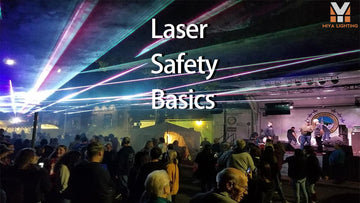
When the term "laser safety" is mentioned, it might conjure thoughts of convoluted regulations and bureaucratic red tape. However, delving into this guide will reveal that ensuring laser safety and compliance need not be as daunting as it seems. Here, we present a detailed exploration of laser safety, from the fundamentals to practical considerations, all aimed at enabling you to incorporate laser light projector into your setup safely and effortlessly.
Section 1: Laser Safety Fundamentals
1.1 The Three Golden Rules of Laser Safety:
Recognizing the Missing Piece: Party-Rocking laser light projector

a. Avoid Aiming Lasers at People: In the United States, maintaining a minimum clearance of approximately 3 meters (10 feet) above the ground is crucial. This separation provides adequate space between the laser light projector and tall individuals. Horizontally, an approximate 2.5-meter (8 feet) clearance is required to prevent laser beams from reaching:
- Mirrors
- Cameras or camera lenses
- Windows
- Surfaces that are reflective or flammable
Achieving proper zoning and alignment is essential in this context. MIYA Laser's M660 laser control system simplifies laser zoning through a lighting console, ensuring a quick, easy, and dependable process.
b. Never Permit Laser Beams into Airspace: Laser beams intersecting with aircraft can result in pilot blindness. Therefore, remember that lasers are meant for neither eyes nor skies. Different countries have varying regulations when it comes to "crowd scanning" or intentionally aiming lasers at people. In the United States, compliance with maximum permitted exposure (MPE) levels is the law and is strictly enforced. We can assist in determining MPE levels for your show and ensuring that your laser light projector aligns with audience scanning requirements.
c. Maintain Reliable Laser Control: In compliance with U.S. law and as a best practice, it is imperative to have a reliable means of halting laser operation. This necessitates that the laser operator undergoes a baseline level of training to ensure safe laser operation and adherence to specific setup and alignment/zoning procedures.
Section 2: Outdoor Use of High-Powered laser light projector
2.1 Safety Considerations for Outdoor Laser Use:
Suitability of Laser Hardware: Before using lazer lights outdoors, ensure that your laser hardware is suitable for such conditions. While few lasers are fully IP65 rated, safeguarding them with proper weatherproof encasement or coverings is advisable. Additionally, refrain from leaving lasers outdoors for extended periods.
U.S. Regulations: For users in the United States, outdoor laser shows fall under the jurisdiction of the Federal Aviation Administration (FAA). Different regulations apply to terminated (where all laser beams stop on a specific target) and unterminated (where beams may unintentionally ascend into the sky) lazer lights. The FAA can approve or disapprove all outdoor laser shows and enforces these regulations with substantial fines for non-compliance.
Section 3: Realistic Laser Risks

3.1 Assessing Laser Safety Realistically:
Laser Injury Incidents: According to data from the FDA, Rockwell Laser Industries, and the U.S. Consumer Protection Agency, there are no documented cases of accidental injury resulting from Class 3A (IIIR), 3B (IIIB), or 4 (IV) laser beams produced by properly constructed and FDA-certified projectors in entertainment settings.
-Intentional and High-Powered Laser Risks: While there are very few instances of deliberate harm caused by lasers, and some undocumented cases of injury from high-powered entertainment lasers, the potential to harm someone with a 3A/3B/4 laser system does exist. This underscores the importance of safety and the need for properly constructed lasers.
MIYA-Laser Commitment: MIAY-Laser is dedicated to manufacturing laser products that surpass the world's most stringent performance and safety standards. With adequate education and attention to safety, virtually anyone can operate an MIYA-Laser system safely and in compliance with the law.
Laser safety is an attainable goal, provided one understands the fundamental rules, abides by regulations, and uses appropriate equipment. Armed with this knowledge, you can confidently and legally integrate lazer lights into your setup, whether for entertainment or professional applications.
